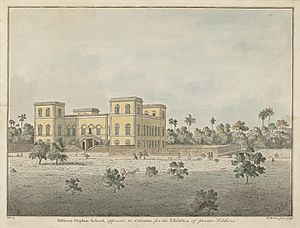William Kirkpatrick (East India Company officer) facts for kids
Quick facts for kids
William Kirkpatrick
|
|
|---|---|
 |
|
| Born | 1754 |
| Died | 22 August 1812 |
| Allegiance | |
| Service/ |
East India Company |
| Years of service | 1771–1812 |
| Rank | Major-General |
William Kirkpatrick (1754–1812) was an officer and diplomat for the East India Company. He was also an expert on Eastern cultures and languages. He worked in Colonial India during the time when the British East India Company ruled parts of the country.
Contents
William Kirkpatrick's Early Life and Career
William Kirkpatrick was born in 1754. His father, Colonel James Kirkpatrick, was also in the Madras army. William started his career as a cadet in 1771. He quickly moved up the ranks in the Bengal infantry.
He became a Persian interpreter for Giles Stibbert, a commander in Bengal. William even translated the army's rules into Persian in 1782. Later, he worked with Mahadji Scindia at Gwalior. He also served as a Persian interpreter for Lord Cornwallis during the Third Anglo-Mysore War (1790–1791).
Diplomatic Missions and Important Roles
In 1793, a Chinese army entered Tibet and moved close to Kathmandu in Nepal. Nepal asked the East India Company for help. Lord Cornwallis offered to help settle the problem. William Kirkpatrick was sent on a special trip to meet Nepal's representatives.
He traveled to Nayakote, where the rulers of Nepal lived. Kirkpatrick and his team were among the first British officers to visit this mountain country, which was not well known to outsiders then.
In 1795, Kirkpatrick became the British representative with the Nizam of Hyderabad. However, he fell ill in 1797 and had to go to the Cape of Good Hope to recover. His brother, James Achilles Kirkpatrick, took his place.
Working with Richard Wellesley
While at the Cape, Kirkpatrick met Richard Wellesley, 1st Marquess Wellesley. Wellesley was a very important British leader. He brought Kirkpatrick back to India as his trusted military secretary.
Kirkpatrick continued to be promoted in the army. He became a lieutenant-colonel in 1798 and a major-general in 1811. Wellesley praised Kirkpatrick for his help against Tipu Sultan, a powerful ruler in India.
After the fall of Seringapatam, Kirkpatrick was one of the people chosen to divide the land of Mysore. For this work, he received a large sum of money. In 1801, he became the British representative at Pune. However, he left India later that year due to poor health.
William Kirkpatrick passed away on August 22, 1812, at the age of 58. He helped start the Bengal Military Fund, which supported soldiers and their families. He also helped choose books for the India Library.
William Kirkpatrick's Writings
Kirkpatrick was very interested in languages and cultures of the East. He wrote a book called Grammar of the Hindoo Dialect and an Arabic and Persian Vocabulary in 1782. The East India Company supported its publication.
He also translated several works from Persian. In 1804, he published a translation of the Diary and Letters of Tippoo Sultaun. In 1811, he wrote an Account of the Mission to Nepaul in 1793, sharing his experiences from that important trip.
William Kirkpatrick's Family Life
William Kirkpatrick married Maria Pawson in 1785. They had four daughters together:
- Clementina, who married Admiral Sir John Louis, 2nd Baronet.
- Barbara, who married Charles Buller, a Member of Parliament.
- Julia, who married Edward Strachey. She was the mother of Sir Edward Strachey, 3rd Baronet.
- Eliza, who never married.
William Kirkpatrick also had two children, Robert and Cecilia, who were educated in England.


